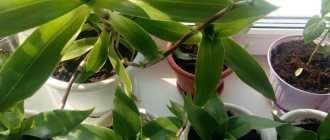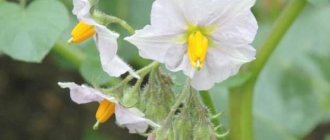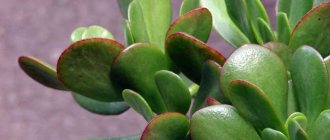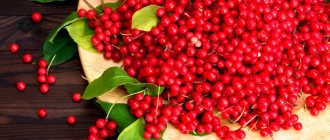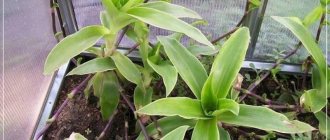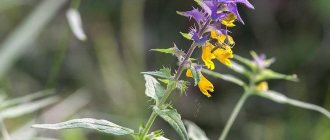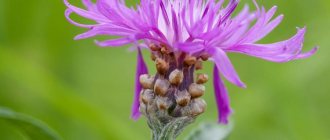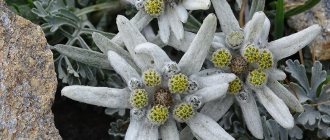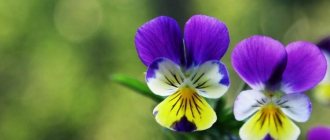Campanula is a flower that got its name for a reason, its shape is a bit like a bell, and this plant is classified as a genus of herbaceous plants, which is defined by the campanaceae family. It looks like a spreading plant on a thickened stem, from which several branches strewn with flowers sprout.
Author of the article
Eduard Dmitriev
Florist and lover of indoor and garden plants.
Description
I met the broadleaf bellflower only once, so there is practically nothing to tell me about it. He grew up on the edge of the forest. The differences from other bells are as follows: the coarse bell and the crowded bell have capitate inflorescences, the peach-leaved bell and the spreading bell have narrow leaves, the rapunzel bell has calyxes that are bent downwards, and the nettle-leaved bell is covered with stiff hairs. All bells together can be seen in the glossary. Another representative of the bell-shaped plants is the lily-leaved bell
- distinguished by a far protruding pistil column.
Food for thought
: It seems to me that there are two different bells represented here. The doubts are as follows: the stem is smooth or ribbed, the sepals are bare or pubescent, the stem is straight, unbranched or branched almost from the base. But, as always, the directory is silent or I don’t know how to ask. According to formal characteristics, the result is the same plant. Let's take note, maybe something will become clearer in the future.
Flowers
Campanula latifolia blooms from June to August. The flowers are large, collected in a long apical raceme.
The dimensions of the corolla are impressive: the length of the corolla is 5 cm or more, the diameter of the corolla is at least 4 cm. The style is shorter than the broom, with a tripartite stigma, there is no suprapistal disc, the stamens in the form of ribbons lie at the bottom of the corolla.
The corolla is purple, bell-shaped, approximately half dissected into slightly bent lobes. The inner surface is pubescent.
Flowers on stalks. The calyx is without appendages between the lobes; the lobes of the calyx are directed upward and slightly deviated. The calyx is glabrous or pubescent, with 5 long, sharp teeth. A barely noticeable stipule sits on the peduncle.
Leaves
The leaves are alternate. The upper leaves are lanceolate, almost entire, sessile, with sparse cilia along the edge.
The middle leaves are lanceolate, toothed, crenate, with a winged petiole, long - 15 cm or more.
The leaves are noticeably pubescent underneath and along the veins.
The lower leaves have a winged petiole, that is, the leaf continues to grow in a narrow strip along the petiole, ciliated.
The lower leaves are wide, ovate, crenate-toothed.
Stem
The stem is up to 1.5 m high, erect, up to 1.5 cm thick.
The stem is bare or slightly pubescent, cylindrical, slightly ribbed at the top.
Fruit
Habitat
Broadleaf bellflower grows in forests, ravines, among bushes on moist soil. I came across it in the western part of the Arbekovsky forest.
Application
The broadleaf bell does not find any particular use, except as an ornamental plant.
More photos:
Add a comment
We definitely read it! There are a lot of books, but there will be fewer questions.
To reduce the amount of spam, each field can only accept strictly defined characters, please pay attention to this!
Top field - your name or nickname (arbitrary), only Latin or Russian letters and space
, everything else will be deleted, length limited to 10 characters;
The bottom field is the place to enter the actual message, the length is limited to 400 characters. Messages with tags, links and malicious code will not be accepted. For a comment to be accepted, limit it to letters, numbers, periods, commas, question marks, and exclamation marks.
- this will help.
Do not write your e-mail in the comments, why do you need tons of spam? If you really want to write a letter, write it not in the comments, but in the appropriate section.
The field bell is one of the popular flowers that can be found in the forest, in the clearing or in the steppe, as well as in gardeners’ decorative plantings. There are many types of it, differing in different shades, some of them have medicinal properties.
Usage
Single plantings , or tapeworm (translated from French as “lonely, solitary”). A single plant planted, in order to attract attention, must be tall, with beautiful leaves, flowers and inflorescences, bloom for a long time and maintain a decorative effect. On the lawn, near a pond, at the fork of paths, you can plant a lush bush of broadleaf bellflower up to 1.5 m high, nettle-leaved, pyramidal and peach-leaved bells with white or blue flowers.
A flowering bush of Campanula lactiflora with numerous light lilac, broadly bell-shaped flowers collected in lush racemose inflorescences, a medium bellflower similar to a bouquet of pink, blue, white or blue flowers in which almost no leaves are visible, looks impressive against the background of dark foliage of trees and shrubs. The thyrsus bell is also interesting for single plantings.
Carpathian bell. © Du-Sa-Ni-Ma
Groups . This is the most common type of perennial planting. A group of large-flowered bells will decorate any lawn, tall plants can serve as a smooth transition from trees and shrubs to the lawn, and shade-tolerant species, such as nettle-leaved, peach-leaved, crowded, rapunzel-shaped, broad-leaved, and dotted bells, will enliven the shaded corners of your garden. The group should not be strictly symmetrical in shape; it is better to arrange it as a natural composition with a smoothly sinuous contour. The planting density of plants in a group depends on the species.
Tall bells (bell-leaved, milk-flowered, nettle-leaved, pyramidal, noble-large-flowered, rapunzel-shaped) are planted in loose groups (at a distance of 45-60 cm) for their better development and greater decorative effect; medium-high ones - 25-30 cm from each other or 6-12 plants per 1 m², and low-growing ones - up to 20 plants per 1 m². Group plantings can be made up of one species, and all bluebells are suitable for such monochromatic colorful groups.
More complex groups are created from bells of different types with different flowering periods. You can also use bells in mixed groups with other perennials (lychnis, trollius, chamomile, etc.), but when selecting plants, it is necessary to take into account the height, flowering time, color and shape of flowers and leaves, and habit.
Nettle leaf bell (Campanula trachelium). © Peter Hanegraaf
Flower rabatka (from German Rabatte - “bed” - is a long strip or “wide ribbon” with parallel sides). Plants are planted in long parallel rows or in a checkerboard pattern. They are placed on the lawn, along paths and retaining walls or platforms. They can be one-sided or double-sided, single-tiered or multi-tiered. On a one-sided ridge, tall plants are planted on the far side (large-spiked bells, Bolognese, pyramidal, broad-leaved, milky-flowered, nettle-leaved, thyrsiform, etc.), low plants are planted closer to the front (Carpathian bells, Altai, Siberian, divergent, border, Gargan, etc. ). You can arrange the plants with a gradual decrease towards the front side, then the ridge becomes multi-tiered. If the background is shrubs or hedges of climbing plants, then the ridge can be decorated with not very tall plants, such as garlic bells, pale ocher, Sarmatian, Hofmann, lyre-shaped, crowded.
Biological description
The field bell belongs to the genus of herbaceous plants of the same family; the Latin name Campanula comes from the diminutive version of the Italian word Campana, i.e. bell; the Russian version was chosen in the same way.
All species of this culture are characterized by a funnel-shaped flower, a tubular corolla consisting of 5 toothed petals diverging upward, which are fused at the base. There are 2 types of inflorescences (paniculate or racemose), crowned with peduncles at the top; occasionally single ones are found.
Its stem can be simple or with branches, in some species it is creeping or creeping. The leaves have an elongated shape, form a basal rosette at the base, and petiolate above.
As a rule, bluebells bloom from late spring to mid-summer for 15-45 days. But there are also later species that bloom in August-September. In addition, some varieties have a long flowering period, up to 3 months. The fruit looks like a capsule with a large number of seeds.
What is the flower formula?
Regina
Flower formula is a symbol for the structure of a flower using letters of the Latin alphabet, symbols and numbers. Starting from the 19th century, formulas and flower diagrams began to be used in educational work and scientific research in botany for greater clarity. When compiling the formula, the following designations are used: P - simple perianth (perianthiutn); Ca (or K) - calyx (calyx); Co (or C) - corolla (corolla); A - androecium (androeceum); G - gynoecium (gynoeceum); the * sign placed at the beginning of the formula indicates the actinomorphism of the flower; up arrow - on its zygomorphy. A bisexual flower is indicated by the sign indicated in Fig. 222, A; male - in Fig. 222, B; female - in fig. 222, V. The “+” sign indicates the arrangement of parts of the flower in two or more circles, or that the parts separated by this sign are opposed to each other. The brackets mean the parts of the flower are fused together. The number next to the symbol indicates the number of members of that part of the flower; the line under the number indicating the number of carpels in the gynoecium indicates that the ovary is superior; the line above the number is the inferior ovary; the line from the number is the semi-inferior ovary. A large and indefinite number of terms is indicated by the sign infinity. Read more…
..She is as beautiful as the dawn, And reveals her petals with a smile... Shines like the trail of a comet. . And he surrounds you with his tenderness...
Among the flowers - like a young queen, Outshines everyone in her regal beauty, Dawn rushes to fall in love with her And bathe her in the midday dew...
She laughs, sparkling drops. . in the embrace of the warm rays of the sun, and plays coquettishly with a petal, captivating hearts with its beauty.
Created for light and for happiness, Creates love in spite of separation, Passion is conquered only by it... And only her hands reach out to caress her...
But be careful with the delicate rose. . Doesn't tolerate rudeness.. and will immediately bleed. It will prick your fingers and give you frost. . Only Love has power over her. .
https://nochnaja-taina.ru/post82137591/ https://dic.academic.ru/dic.nsf/ruwiki/213899 https://www.aworld.ru/texta/?259
Exclusive
Constriction Engineer
Recording the number of petals, stamens, pistils, sepals and other nonsense.
Classification and popular varieties
There are almost 300 species of bells in the world. According to the duration of the life cycle, they are divided into one-, two- and perennial, the latter of which have many varieties and interspecific hybrids.
Based on their habitat they are classified into the following types:
In Russia, in forests, clearings, floodplains and steppes you can find more than 10 species of field bells, blooming from late spring for almost the entire summer season.
The most popular varieties of this flower, which are often used to decorate summer cottages and garden plots:
- The bell is spreading. This modest-looking flower loves light-colored copses, meadows, and ravine slopes, blooming in early June. The stem usually does not exceed 60 cm in height and branches upward. The plant is biennial, differs from others in having a dissected flower corolla of 5 lobes, oblong leaves with sharp tips arranged in a spiral.
- Peach-leaved. Considered a model of beauty among its fellows, the flower has a sky-blue hue, the petals are fused, and grows in fields, sparse forests, near paths and paths. It was this species that was first domesticated in Europe.
- The bell is crowded. It is a dwarf species, reaching a height of 30 to 60 cm, the stems are very thin, the flowers are small, collected in bunches, and have a dark blue-violet hue. Flowering time is from late June to mid-August.
- Nettle-leaved. Prefers wet and damp ravines, common in the middle zone, can grow up to 140 cm in height, has strong stems covered with hairs. Its leaves are similar in shape to nettles, the inflorescences are grouped up to 3 pieces in a raceme near the apex and in the axils, the corolla has a lilac-blue tint.
- Broadleaf. It is found in ravines, between bushes in the forest, and blooms later than all other varieties, usually in July-August. The leaves are large in size, 10-15 cm in length, located at the base. The stems are straight and strong, reaching a height of up to 130 cm. The flowers can be blue or pale purple, arranged in 1-3 pieces. The species has been cultivated and many varieties have been bred.
Please write the formula of the Asteraceae flower. But not in Latin.
Alex
1. The inflorescence is a basket, surrounded by a wrapper of green leaves. 2. The perianth is always double, but the calyx, as a rule, is not developed. *H (5)L (5)T5P1 or *L (5)T (5)P1. 3. The fruit is an achene. Usually crested, flying. 4. The basket contains tubular (thistle), funnel-shaped (cornflower) or reed (dandelion) flowers.
Elena Snigireva
Double perianth, corolla of 5 petals fused into a tube, 5 stamens, 1 pistil,
Valia Ovs
Asteraceae or Asteraceae
Flower formula: L (5) T (5) P1
The inflorescence is a basket. The fruit is an achene. The calyx has become hairy or is missing.
The flowers have a double perianth. The calyx usually does not develop in sunflower and aster, or is represented by a tuft in cornflower. The corolla is formed from 5 petals fused into a tube, 5 stamens and 1 pistil.
Tatiana Simanova
The flowers are small, collected in basket inflorescences, surrounded by a wrapper. The calyx is strongly reduced, the corolla is fused-petalled, five-lobed; There are four types: tubular, ligular, false lingual and bilabial funnel-shaped (funnel-shaped). The tubular flowers are bisexual with five small lobes of a fused-petalled corolla; in false tongues, the lower lip consists of three fused petals, ends with three teeth and looks like a more or less long tongue. These flowers are only pistillate. Tubular flowers are located in the center of the inflorescence, and false-lingual flowers are often located along the edge of the inflorescence (chamomile, sunflower, elecampane). Funnel-shaped flowers have a fused-petaled corolla of five teeth, the flowers are asexual, usually in marginal inflorescence (cornflower); reed flowers consist of five petals fused in one plane. These flowers are bisexual, often completely forming an inflorescence; have five stamens fused with anthers; one pistil and a fruit - an achene. The sunflower basket consists of tubular (in the middle) and false-ligulate (along the edge of the inflorescence) flowers. Blue cornflower (weed) has tubular flowers in the center of the inflorescence, and funnel-shaped flowers along the edge. Dandelion has baskets only with reed flowers, and thistle has only tubular flowers. Many Asteraceae (or Asteraceae) have decorative value (for example, dahlias, asters, chrysanthemums, daisies).
Natalia Tarasenko
*L (5) T (5) P1
Mountain views
Such bells are medium-sized, having a maximum height of up to 80 cm. The most popular Caucasian species among them are:
- Round-leaved. It is distinguished by a more rounded shape of leaves collected near the root, which die off during the flowering period. The petals are colored blue. The plant has medicinal properties.
- Takeshima. A winter-hardy crop, decorated with double flowers with pink, lilac or blue petals, collected in racemose bunches, the heads hanging down.
- Spot. Large white and pink-purple flowers are collected in paniculate inflorescences and appear drooping.
- The bell is medium. The most spectacular and popular look. Breeders have developed many interesting varieties of it.
Need flower formulas...
Elena Schastlivaya
Flower formula: CH5L5T∞P∞ Inflorescence – raceme. The fruit is a composite drupe (raspberry, blackberry).
Flower formula is a symbol for the structure of a flower using letters of the Latin alphabet, symbols and numbers. Since the 19th century, in educational work and scientific research in botany, formulas and flower diagrams began to be used for greater clarity. At the beginning of the formula, the symmetry sign of the flower is indicated:
* \ast — regular flower (actinomorphic) * \uparrow — irregular flower (zygomorphic)
The following are letter expressions characterizing the perianth, stamens, and pistil:
* Ca or K (in Russian Ch) - calyx (calyx) * Co or C (in Russian B) - corolla (corolla) * P (in Russian O) - simple perianth (perigonium) * A (in Russian T) - stamens (androceum) (androceum) * G or g (in Russian P) - pistil, carpels (gynoecium) (gynoeceum)
She
go to the SAGITTARIUS website. there is.
Dwarf varieties
Low-growing species of field bell include:
- Carpathian. Decorative variety with a long flowering period of up to 70 days. It grows in bushes with a diameter of 20-30 cm, abundantly strewn with small flowers in shades of blue, lilac and white.
- Daisy leaf. A perennial winter-hardy plant that forms dense turf up to 15 cm in height. The flowers look vertically upward, blue or purple, located one on each low stem.
Growing and care
Basic rules for planting and watering field bells:
- plants love sunny places and cannot tolerate close groundwater, as this can cause the root system to freeze;
- the soil is preferably loamy, neutral or slightly alkaline, sand and humus are also added, prepared in advance with the addition of rotted manure, fertilizers, drainage is placed down;
- watering is moderate, during the growth period it is useful to apply fertilizers with nitrogen, when laying buds - mineral fertilizers;
- loves loose soil, which also helps in the fight against weeds;
- dry, faded parts of the plant should be removed immediately, which will open up space for new buds;
- seed boxes must be collected, preventing self-sowing;
- perennial varieties are covered with peat, dry leaves or spruce branches for the winter.
Each species also has its own nuances and characteristics of cultivation and care.
Perennial bells after flowering
When and how to collect seeds
If you decide to collect seeds from bluebells, you should cut the capsules after they turn brown, rather than waiting until they open. Place the cut boxes in a dry and ventilated place and wait until the seeds ripen.
Preparing for winter
Perennials, unlike annuals and biennials, must be prepared for wintering. In the last September or first October days, you will need to cut off all the shoots at the root. After this, you no longer need to care for annuals. Perennials and biennials, as a rule, can survive the winter without shelter, but southern species must be sprinkled with spruce branches or dried leaves. Tall species should be sprinkled with dry peat or humus, and the layer should have a thickness of 15 to 20 centimeters.
Reproduction
Wildflowers bells reproduce in 3 ways:
- seeds - annual species;
- cuttings and seeds - biennial;
- vegetative propagation or long root cuttings.
Black small seeds of annuals, extracted from a dried capsule, are sown in late autumn directly into open ground. You can make seedlings for planting in the spring, after frost, in the 3-leaf phase.
The vegetative method is perfect for southern heat-loving varieties, as well as for preserving the desired genetic characteristics (doubleness, etc.). The division of the plant is carried out in the spring of the 3rd year, with the exception of quickly maturing species that can produce planting divisions in the fall.
When dividing, an adult bush is dug up, the ground shoots are cut off, and the rhizome is divided so that each part necessarily has a growing point. When planted in ditches, it should remain above the surface of the ground.
When cuttings, young shoots of the plant are used, separating them in the spring of the 2nd year.
Breeding methods
Annual bells reproduce only by seeds, biennials by seeds and spring cuttings. Most perennial species are propagated by dividing the bush, as well as by stolons and root cuttings.
Vegetative propagation is important for varieties and garden forms, especially those with double flowers that do not set seeds. Their clumps are suitable for division starting from the third year of life. Peach-leaved, Takeshima, crowded, and spoon-leaved bells tolerate division well in the first year of flowering.
Plants are divided in early May or in the second half of August. Root suckers are separated from the mother plant as soon as they develop their own root system. Spring young shoots are taken for cuttings.
Sowing seeds
Bell seeds can be sown in autumn and spring (May). They germinate in 10–14 days. Pre-winter crops germinate in the spring. Many types of bells bloom in the first or second year of life.
Bellflower pests and diseases
The plant is a resistant species that is rarely susceptible to disease. However, when growing a crop in the same place for a long period, the development of fungal diseases is possible. Therefore, as a preventative measure, it is recommended to treat the soil and the seedlings themselves with a solution of Fundazol.
With prolonged moisture, rotting of the neck or the roots themselves may occur, but this can be avoided by providing drainage during planting and regularly loosening the soil. Watering should be done moderately.
Among the pests, the plant is most often attacked by slugs, from which it must be treated with metaldehyde.
Relatives of the plant
In structure and appearance, there are wildflowers similar to bells:
- Foxglove (digitalis). The plant belongs to the herbs of the plantain family; beautiful pink and lilac flowers, arranged in bunches on the stem, are shaped like the fused petals of a bell.
- Lilies of the valley. A plant with small white flowers, common in temperate countries.
- Grouse (fritillaria). A herbaceous perennial from the lily family, there are 150 species, growing in temperate climates. The Russian name comes from the words “pockmarked, motley”.
Please write the color formulas: Rose, lily, lily of the valley))))
Alilova AK
Rose family Rosaceae Ch5L5T∞P∞. Lily and lily of the valley - lily family L6T6P1
Dita
Rose *H 5L5T\P\ Conventions (for drawing up a flower formula): * - the flower is correct; | - the flower is wrong; O - simple perianth, consisting of only sepals or only petals; () - fusion of flower parts; \ - an indefinitely large number of flower parts; Ch - sepals; L - petals; T - stamens; P - pistils.
Lily: * P3+3 A3+3 G_(3)
* - regular flower (actinomorphic); P3+3 - simple perianth; the petals are free, arranged in two circles of three petals; A3+3 - stamens are free, arranged in two circles of three stamens each; G_(3)—one pistil, formed by three fused carpels (coenocarpous gynoecium); superior ovary.
Lily of the valley: The flowers have a rounded bell-shaped perianth of white (less often pale pink) color, with 6 bent lobes; 6 stamens sitting on the perianth, and a rounded ovary ending in a short style. Long curved pedicels with membranous bracts. Fragrant flowers droop gracefully. Blooms in May - June.
Flower formula: *P3+3A3+3G(3_)
Field bell: beneficial properties and contraindications
Several types of plants are used in folk medicine. The bluebell has the greatest healing effect. To prepare decoctions and infusions from this culture, all parts of the plant are collected, except for the roots. The optimal time for harvesting is the flowering period. It is better to collect in places of mass growth (see photo of the crowded bellflower below).
The beneficial properties of the field bell are due to the content of active substances: carotene, kaempeferol, citric and caffeic acid, magnesium and potassium. The prepared medicinal infusions have a calming effect on the peripheral nervous system, are successfully used in the treatment of inflammatory processes in the throat, for coughs, and are used in the form of compresses to relieve the symptoms of rheumatism and wound healing.
Recipes for medicinal decoctions and infusions:
- The decoction is made from 3 tbsp. l. dry mixture in 0.5 liters of water, boil for 5 minutes. Covered, leave for 1 hour, strain and squeeze. Use ½ tbsp. after meals to strengthen the body during viral and infectious diseases.
- To treat sore throat, stomatitis and other throat diseases, rinse with bellflower decoction: 2 tsp. herbs for 1 tbsp. boiling water
- An infusion to reduce pain in the stomach and kidneys can be prepared from 20 g of dry herb per 0.5 liter of boiling water. Leave for 2 hours, then filter. Drink 2/3 tbsp. for pain. The maximum daily dose is 2 glasses.
- A calming and relaxing bath is made with the addition of infusion (100 g of dry mixture per 1 liter of boiling water, leave until cool). Strain the liquid and add to the prepared bathing water.
- Relieving joint pain and treating radiculitis. This is done using a compress soaked in a decoction prepared from 2 tbsp. l. dry herbs for 1 tbsp. boiling water It needs to be infused for 40 minutes, then strained. The compress is applied to the sore spot several times a day.
What kind of plant is the bellflower?
In addition to beautiful flowers, as well as good melliferous properties, some types of this plant even have edible parts, from which you can make, for example, salad. Also, some types of this plant have healing properties.
All parts of the plant can be used for medicinal purposes, primarily:
Flowers are harvested during flowering periods; during collection, care should be taken to ensure that insects do not get in with them. Flowers are dried in the shade at a temperature not exceeding 40°C and stored in a cool, dark place in fabric bags. Meadow bell is often used in folk medicine.
The composition of its flowers includes acids such as caffeic and coumaric, as well as carotene, phosphorus and calcium, and other useful substances.
Various remedies are prepared from bells, which are used in folk medicine.
Decoctions of bluebell flowers have a calming effect and mild pain relief. And the leaves of this plant contain a fairly large amount of ascorbic acid. The field bell contains many acids and beneficial substances that have a beneficial effect on the human body. The leaves, stems and flowers of this plant are used in folk medicine and are widely used to treat, for example, colds. Decoctions and teas from bellflower are often used as an adjuvant in the treatment of gastrointestinal tract and cardiovascular diseases. The common bellflower is also widely used in folk medicine; decoctions and infusions are prepared from the plant, which are good against coughs, acute respiratory viral infections, and have a sedative effect. It is used as compresses that help cope with rheumatism, and lotions promote faster healing of wounds.
Classification of bell types: meadow and many others
Numerous types of bells are conventionally divided into groups according to various characteristics. Thus, in terms of life expectancy, the main part of them are perennials, a much smaller proportion are biennials, and several species are annuals.
Among biennials, the most famous is the middle bell; bells are less common in gardens:
Annuals are rare in our climate zone; they usually grow in more southern regions.
From this group, annual bellflower is found in gardens.
Bells are much less common:
And its varieties:
An important classification feature that determines the characteristic biological properties of a plant, and, consequently, the features of caring for it, is its natural habitat. On this basis, all species are divided into field, forest and mountain.
Field bells crowded, spreading, rapunciform, Bolognese, small, etc. are unpretentious, light-loving, winter-hardy and drought-resistant.
Forest moisture-loving and shade-tolerant species:
Mountain bells:
They are somewhat capricious, need sun, calcareous soils and good drainage, but due to their miniature size and long flowering they are very popular. They are especially good for alpine slides; they also look good in curbs.
According to their height, bells are divided into tall, medium and low. Most forest species belong to the tall group; mountain varieties are usually compact in size.
The following are detailed descriptions of some of the most famous and commonly found species in our gardens, grouped by habitat in nature.
Common types of garden bells
Among the cultivated field bells, the most common are:
Crowded bell (C. glomerata), a medium-sized perennial with strong, erect, simple or slightly branched stems 30-60 cm high. The lower rosette leaves are petiolate, oblong or lanceolate, the stem leaves are alternate, sessile or partially entwining, more rounded in shape. The leaf blades, like the stems, are covered with soft hairs. The capitate inflorescence, apical or axillary, consists of funnel-shaped bell-shaped flowers, blue-violet, less often white, located on short pedicels and directed upward, up to 2 cm in diameter.
In cultivation since the mid-16th century, it is distinguished by its extraordinary vitality and plasticity, and forms a compact, low-growing bush. Like any meadow bell, it is drought-resistant, grows well in sunny places with fairly poor soil, and tolerates light shade. Blooms for 30-35 days in mid-summer.
There are many garden forms, including:
Large-flowered white Superba
Superbus dark purple color.
A dwarf variety Acaulis, whose height is 10-15 cm, was bred especially for rocky hills. Varietal forms reproduce only vegetatively, natural ones can be grown from seeds.
Round-leaved bellflower (C. rotundifilia) is a low-growing perennial rhizomatous plant with numerous stems forming loose clumps 10-40 cm high. In nature, it is found on dry sandy soils of short-grass meadows, slopes and forest edges. The name of the flower is given for the shape of the basal leaves, long-petioled, round or heart-shaped, with a jagged edge and a diameter of about 1.5 cm. By the time of flowering, they usually die off, leaving only stem leaves, short-petioled, lanceolate, whole or serrated. Numerous bright blue, light blue or white flowers up to 2 cm in diameter are collected in a loose panicle inflorescence. In cultivation, the plant is valued for its long, abundant flowering, from late spring to September. Prefers sunny places, usually planted in rock gardens.
Bellflower (C. boloniensis) is a perennial 50-120 cm high with simple, slightly branched, roughly pubescent stems. Whole ovate or broadly lanceolate leaves, petiolate at the bottom and entwined at the top of the stem, have short, almost felt-like pubescence at the bottom. Light blue, drooping, funnel-shaped flowers with a diameter of 1.5-2 cm are collected in an apical raceme.
In nature, the species grows in the Mediterranean, Western Siberia, Central Europe, the Caucasus, and is found in the steppes, on rocky slopes, and dry pastures. On the territory of Russia, this steppe bell is considered a rare plant and is listed in the regional Red Books of various regions. In gardens it is used for landscape-style plantings; it prefers sun or partial shade. Blooms from June to August.
Planting a bell in open ground
Do-it-yourself planting work is carried out according to a standard algorithm. If all requirements are met, the crop will delight you with its bright buds throughout the summer season.
Growing bells from seeds
Before planting, preliminary preparation of the seed material is carried out; ordinary paper and a saucer are used for it. The seeds are scattered onto a moistened sheet, which is carefully transferred to a plate filled with water. After the first shoots appear, the young plants are transplanted into prepared soil.
The soil should be loose and light, with good drainage. It is moistened, and the seeds are pressed in a little. After repeated spraying, the boxes are covered with plastic wrap and moved to a warm room.
After 14 days, seedlings will appear, after which it is necessary to remove the covering material. The seedlings are allowed to grow and become stronger, the soil is regularly loosened and watered. If the plantings are too dense, a dive is carried out - when the first two leaves are formed.
Important! The healthiest individuals are carefully transplanted into separate containers.
What you need to plant bluebells
The plant is distinguished by its love for diffused lighting and stable temperature conditions, not lower than 15 degrees. The soil is constantly loosened and irrigated, the green part is sprayed. You need to care for young individuals carefully so as not to accidentally injure the thinnest branches.
Transplantation is carried out in the spring - the plants are removed from the pots along with a lump of earth and transferred to previously prepared holes. The voids are filled with substrate, compacted and watered.
Important! To prevent problems with rooting, it is necessary to regularly remove weeds growing near the crop.
How to choose the optimal location
When planting in fresh air, choose a place located away from tall and branchy shrubs and spreading trees that may block the sun. The plant prefers to grow on calcareous and slightly alkaline soils with good drainage.
The distance between the bushes depends on their final size:
- for tall people - not less than 0.5 m;
- for medium-sized children – 0.3 m;
- for miniatures – 10 cm.
Important! When forming an alpine hill, large-sized plants are planted in the background, medium-sized plants are planted in the middle, and the smallest bushes are planted in front. To emphasize the beauty of the crop, it is surrounded by lawn grass.
Bells in the open ground
How to feed bells for lush flowering
When planting, do not forget about turf and fertilizers. Peat, manure and bird droppings are prohibited - they are sources of fungal infections. Preventive treatment against diseases and insect pests is carried out using granulated superphosphate.
To obtain the most lush flowering, fertilizers are introduced into the soil:
- primary fertilizing is prescribed for spring - a composition containing nitrogen is purchased for it;
- secondary - after the formation of the first buds, during this period it is better to use complex mixtures.
Important! To increase the number of flowers, it is necessary to promptly get rid of wilted inflorescences. The duration and splendor of flowering depends on following the rules of regular crop renewal: shrubs need to be transplanted to new places. Polite and careful care will allow you to create a flower garden of extraordinary beauty.
Description of the spreading bell
Spreading bellflower (C. patula) is one of the most common wild species in Europe, a biennial 30-60 cm high with straight faceted stems, pubescent at the bottom, bare and branched at the top. The leaves are alternate, short-petiolate elliptical below, sessile lanceolate above. The flowers are lilac or violet, funnel-shaped, with long pedicels, collected in a loose spreading paniculate inflorescence.
It blooms from May to August, after flowering it loses its decorative effect. It is rarely grown in gardens, mainly as a component of a Moorish lawn or a natural-style flower garden. As can be seen from the description, the spreading bell is one of the earliest flowering species, blooming already in May. It is recommended to plant it next to other plants, which in the future will be able to disguise faded stems that have lost their attractiveness. In the garden it reproduces by self-sowing.
Planting in open ground
Growing from seeds
Note. Seeds need preliminary preparation. You will need paper and a saucer. Using your hand, carefully scatter the seeds onto pre-moistened paper and lower it along with the seeds onto a saucer of water. When small sprouts appear, they can be planted in previously prepared soil.
The soil should be loose and well drained. It is moistened, the seeds are lowered into it, slightly pressing. Next, you need to moisten it with a spray bottle and cover it with cling film on top. Place in a warm place. In two weeks they will sprout. When the seedlings become stronger, the film is removed. The soil must be loosened and watered regularly. Plantings that are too dense need to be pruned in the future. This procedure is carried out when the first pair of true leaves appears on the stems. The plant is poured generously with water, the sprouts are carefully removed, and then transplanted into a larger container, possibly in a separate pot.
Forest bell: dotted, medium and other types
A large group of decorative bells consists of forest species.
These include:
Bellflower (C. persicifolia), a frequently grown perennial plant belonging to the group of perennials. Straight or weakly branched stems grow up to 30-70 cm, petiolate basal and sessile stem leaves, oblong or linear-lanceolate, shaped like peach leaves. Large, up to 4 cm in diameter, flowers, painted in blue and white tones, are collected in a loose racemose inflorescence, blooming in June-July.
The species grows in forests throughout Russia, but its numbers are constantly declining due to the uncontrolled collection of attractive inflorescences for bouquets. It has long been grown in garden culture, valued for its unpretentiousness, the ability to grow both in the sun and in the shade, on soils of any composition.
There are many garden forms and cultivars, differing in size and color of inflorescences.
So, varieties:
Celestina and Blaukelchen have terry blue,
Moyerheimin - double white flowers.
There are also two-color colors: the Marginata cultivar has a white corolla with a blue border. The natural species reproduces well by self-sowing; cultivated forms can only be propagated vegetatively, by root suckers.
Broad-leaved bellflower (C. latifolia), one of the largest-flowered and tallest species, has long been and often grown in our gardens. A perennial plant with straight bare stems up to 1.5 m in height, large pubescent leaves, rounded petiolate at the bottom of the stem, sessile lanceolate at the top, and large, in some varieties reaching 7 cm in length, bell-shaped flowers with pointed petals. The flowers are blue, purple, less often white, collected in a sparse spike-shaped raceme, blooming in the axils of the leaves.
Flowering time is June-July. The plant is ideal for the background of landscape gardens; it is durable, shade-tolerant, and undemanding to soil. It has been used in culture for a long time; the first mention of it as a garden flower dates back to 1576.
Not only the original natural form of blue color is grown, but also a number of cultivars:
Dark purple grandiflora Macrantha
Bright purple Brandwood .
The varieties are easily propagated by dividing the bush; the natural form is propagated by seeds.
Pointed bell (C. punctata), moisture-loving, medium-sized, 30-60 cm tall, representative of the flora of the Far East, also found in China, Japan and Korea.
In nature, this perennial grows in forests, bushes, along river banks and in shallows. Its straight, branching stems from above are densely pubescent; the leaves, petiolate, heart-shaped below and on non-flowering shoots, broadly lanceolate, sessile or with short stem petioles, are also covered with hard short pubescence.
The name of the species reflects the original appearance of its flower, large, in some cultivars up to 9 cm long, drooping, goblet-shaped, inside, and in some forms also outside, covered with bright crimson dots. Individual flowers are collected in a dense cluster and bloom in mid-summer.
The plant is becoming increasingly popular in cultivation; it is winter-hardy, shade-tolerant, moisture-loving, and forms many underground shoots, due to which the curtains actively grow, gradually turning into a dense flowering carpet.
The natural form is white, cultivated varieties have a variety of colors: reddish in Othello, pink with a white edging and numerous purple dots in Cherry Bell, bright blue in the tall (up to 75 cm) cultivar Kent Bell.
Bluebell medium (C. medium) is a very decorative biennial species, whose natural habitat is the light forests of Southern Europe and Asia. A medium-sized plant with lanceolate leaves and a powerful taproot in the first year of vegetation forms a rosette of basal pubescent leaves, from which in the second year a strong straight peduncle 50-100 cm high grows, like the leaves, covered with hard, dense hairs. The flowers are large, up to 7 cm in length and diameter, bell-shaped, collected in dense clusters, bloom in June-September. The shoots die off after flowering, but in their place new stems can form that will bloom next summer.
This decorative bell is more whimsical than other types; it requires a sunny location, nutrient-rich non-acidic soils, sufficient moisture, and shelter for the winter. Due to the taproot system, it does not tolerate transplantation well, especially in adulthood. Propagated by seeds, often self-sows.
Despite some difficulties in care, it is popular among flower growers, looks impressive in garden compositions, and is suitable for cutting. Cultivated since the 16th century, numerous garden forms with simple and double flowers are painted in a wide variety of colors: white, blue, light blue, pink, purple.
Flower structure
A flower is the reproductive organ of angiosperms, consisting of a shortened stem (flower axis), on which the flower cover (perianth), stamens and pistils, consisting of one or more carpels, are located.
The axis of the flower is called the receptacle. The receptacle, growing, takes on various shapes: flat, concave, convex, hemispherical, cone-shaped, elongated, columnar. The receptacle below turns into a peduncle, connecting the flower with the stem or peduncle.
Flowers without a peduncle are called sessile. On the peduncle of many plants there are two or one small leaves - bracts.
The cover of the flower - the perianth - can be divided into a calyx and corolla.
The calyx forms the outer circle of the perianth; its leaves are usually relatively small in size and green in color. There are separate and fused calyx. Usually it serves the function of protecting the internal parts of the flower until the bud opens. In some cases, the calyx falls off when the flower opens; most often it remains during flowering.
The parts of the flower located around the stamens and pistil are called the perianth.
The inner leaves are the petals that make up the corolla. The outer leaves - sepals - form a calyx. The perianth, consisting of a calyx and corolla, is called double. A perianth that is not divided into a corolla and a calyx, and all the leaflets of the flower are more or less the same - simple.
The corolla is the inner part of the perianth, differs from the calyx in its bright color and larger size. The color of the petals is due to the presence of chromoplasts. There are separate and fused corollas. The first consists of individual petals. In fused-petal corollas, a tube is distinguished and a limb located perpendicular to it, which has a certain number of teeth or corolla blades.
Flowers can be symmetrical or asymmetrical. There are flowers that do not have a perianth; they are called naked.
Symmetrical (actinomorphic) - if many axes of symmetry can be drawn through the corolla.
Asymmetrical (zygomorphic) - if only one axis of symmetry can be drawn.
Double flowers have an abnormally increased number of petals. In most cases they occur as a result of petals splitting.
A stamen is a part of a flower, which is a kind of specialized structure that forms microspores and pollen. It consists of a filament, through which it is attached to the receptacle, and an anther containing pollen. The number of stamens in a flower is a systematic feature. Stamens are distinguished by the method of attachment to the receptacle, by shape, size, structure of the stamen filaments, connective tissue and anther. The collection of stamens in a flower is called the androecium.
The filament is the sterile part of the stamen, bearing an anther at its apex. The filament can be straight, curved, twisted, tortuous, or broken. Shape: hair-like, cone-shaped, cylindrical, flattened, club-shaped. The nature of the surface is bare, pubescent, hairy, with glands. In some plants it is short or does not develop at all.
The anther is located at the top of the filament and is attached to it by a connective tissue. It consists of two halves connected to each other by a connector. Each half of the anther has two cavities (pollen sacs, chambers, or nests) in which pollen develops.
As a rule, the anther is four-locular, but sometimes the partition between the nests in each half is destroyed, and the anther becomes two-locular. In some plants the anther is even single-lobed. Very rarely found with three nests. Based on the type of attachment to the filament, anthers are classified into immobile, movable, and oscillating anthers.
Anthers contain pollen or pollen grains.
Pollen grain structure
The dust particles formed in the anthers of the stamens are small grains; they are called pollen grains. The largest ones reach 0.5 mm in diameter, but usually they are much smaller. Under a microscope you can see that dust particles from different plants are not at all the same. They differ in size and shape.
The surface of the dust particle is covered with various protrusions and tubercles. Once on the stigma of the pistil, the pollen grains are held with the help of outgrowths and the sticky liquid secreted on the stigma.
The nests of young anthers contain special diploid cells. As a result of meiotic division, four haploid spores are formed from each cell, which are called microspores due to their very small size. Here, in the cavity of the pollen sac, microspores turn into pollen grains.
This happens as follows: the microspore nucleus is divided mitotically into two nuclei - vegetative and generative. Areas of cytoplasm are concentrated around the nuclei and two cells are formed - vegetative and generative. On the surface of the cytoplasmic membrane of the microspore, a very strong shell is formed from the contents of the pollen sac, insoluble in acids and alkalis. Thus, each pollen grain consists of vegetative and generative cells and is covered with two membranes. Many pollen grains make up the pollen of a plant. Pollen matures in the anthers at the time the flower opens.
Pollen germination
The beginning of pollen germination is associated with mitotic division, as a result of which a small reproductive cell is formed (sperm cells develop from it) and a large vegetative cell (the pollen tube develops from it).
After the pollen reaches the stigma in one way or another, its germination begins. The sticky and uneven surface of the stigma helps to retain pollen. In addition, the stigma secretes a special substance (enzyme) that acts on pollen, stimulating its germination.
The pollen swells, and the restraining influence of the exine (the outer layer of the pollen grain shell) causes the contents of the pollen cell to rupture one of the pores, through which the intina (the inner, poreless shell of the pollen grain) protrudes outward in the form of a narrow pollen tube. The contents of the pollen cell pass into the pollen tube.
Under the epidermis of the stigma there is loose tissue into which the pollen tube penetrates. It continues to grow, passing either through a special conducting channel between mucus cells, or tortuously along the intercellular spaces of the conductive tissue of the column. In this case, usually a significant number of pollen tubes simultaneously advance in the style, and the “success” of one or another tube depends on the individual growth rate.
Two sperm and one vegetative nucleus pass into the pollen tube. If the formation of sperm cells in pollen has not yet occurred, then a generative cell passes into the pollen tube, and here, through its division, sperm cells are formed. The vegetative nucleus is often located in front, at the growing end of the tube, and sperm are successively located behind it. In the pollen tube, the cytoplasm is in constant motion.
Pollen is rich in nutrients. These substances, especially carbohydrates (sugar, starch, pentosans) are intensively consumed during pollen germination. In addition to carbohydrates, the chemical composition of pollen includes proteins, fats, ash and a large group of enzymes. Pollen contains a high phosphorus content. Substances in pollen are in a mobile state. Pollen easily tolerates low temperatures down to – 20Cº and even lower for a long time. High temperatures quickly reduce germination.
Pestle
The pistil is the part of the flower that forms the fruit. It arises from the carpel (a leaf-like structure bearing ovules) subsequently fusion of the edges of the latter. It can be simple if it is made up of one carpel, and complex if it is made up of several simple pistils fused together with side walls. In some plants, the pistils are underdeveloped and are represented only by rudiments. The pistil is divided into ovary, style and stigma.
The ovary is the lower part of the pistil, which contains the seed buds.
Having entered the ovary, the pollen tube grows further and enters the ovule in most cases through the pollen duct (micropyle). Invading the embryo sac, the end of the pollen tube bursts and the contents spill onto one of the synergids, which darkens and quickly collapses. The vegetative nucleus is usually destroyed before the pollen tube penetrates the embryo sac.
Flowers regular and irregular
The tepals (simple and double) can be arranged so that several planes of symmetry can be drawn through it. Such flowers are called regular. Flowers through which one plane of symmetry can be drawn are called irregular.
Flowers bisexual and dioecious
Most plants have flowers that contain both stamens and pistils. These are bisexual flowers. But in some plants, some flowers have only pistils - pistillate flowers, while others have only stamens - staminate flowers. Such flowers are called dioecious.
Monoecious and dioecious plants
Plants that bear both pistillate and staminate flowers are called monoecious. Dioecious plants have staminate flowers on one plant and pistillate flowers on another.
There are species in which bisexual and unisexual flowers can be found on the same plant. These are the so-called polygamous (polygamous) plants.
Carpathian bluebell and other mountain species
Representatives of mountain species are also widely represented in decorative floriculture; these, mostly low-growing plants, are especially suitable for alpine hills and rocky gardens.
Most often grown:
Carpathian bellflower (C. carpatica), a compact perennial not exceeding 10-15 cm in height. The species’ homeland is the Carpathians, where it is classified as endangered and is even listed in the Red Book, but the flower has long been widely used in cultivation as a spectacular plant for rock gardens.
The Carpathian bell has thin, brittle, leafy shoots, small rounded-ovate leaves, in the basal part with long petioles, collected in a dense rosette, on the stem - with short petioles, arranged alternately. At the ends of the shoots, large, up to 4 cm in diameter, single, upward-pointing, wide-bell-shaped flowers bloom, the color of which, depending on the variety, can be blue, white, indigo or purple.
The plant feels great in the conditions of central Russia, where it successfully winters without shelter. Valued for its unusually long flowering period, beginning in June and lasting up to 70 days. Prefers a sunny or semi-shaded location, dry, well-drained soil, and requires virtually no watering. Grows well, forming dense compact bushes. The disadvantages of the culture include its fragility; in one place without replanting, a flower can grow for no more than 2-3 years, after which it usually freezes.
Garden forms include:
Benefits of bellflower seeds
Most species of this plant successfully bear fruit, but there are also some that do not bear fruit. The seeds of this plant are formed in special boxes with an oblong shape. When the seeds ripen in the capsule, 3–6 slit-like holes are formed.
The seeds of this plant themselves are small, their color can be white or brown. Typically, seeds remain viable for 3 years.
The seeds of the bell, depending on the species, vary in size; they range from microscopic sizes to larger specimens. In wild conditions, the seeds themselves spill out onto the ground from the capsules. And if the plant is cultivated, then the seeds should be mixed with sand for ease of sowing. When growing in the garden and for further planting of new plants, fruiting capsules should be collected before sowing the seeds.
